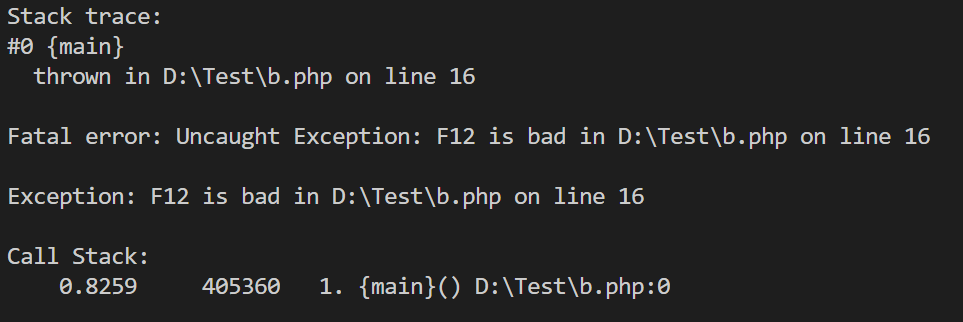前言
gc的全称是garbage collection也就是垃圾回收的意思,在php中,是使用引用计数和回收周期来自动管理内存对象的,当一个对象被设置为null,或者没有任何指针指向时,他就会变成垃圾,被gc机制回收掉。
环境配置
php.ini终配置好xdebug,xdebug_debug_zval是用来查看容器变量内容的函数
<?php
$a = "f12";
xdebug_debug_zval("a");
?>
在php gc机制中,当程序终止时就会让变量的refcount减1,如果refcount-1为0的话,就会销毁回收该变量
引用计数
is_ref表示该变量是否被引用,操作系统学的好的同学应该很容易理解该内容
<?php
$a = "f12";
$b = &$a;
xdebug_debug_zval("a");
?>
# 运行结果
a: (refcount=2, is_ref=1)='f12'$b是$a的引用,所以is_ref=1,同时refcount也会加1,因为此时是有两个变量的(两变量指向同一个地址),所以销毁时要让refcount减2。
当变量是array类型时,也是一样的规则
<?php
$a = "f12";
$arr = array(0=>"test", 1=>&$a);
xdebug_debug_zval("arr");
?>
# 运行结果
arr: (refcount=1, is_ref=0)=array (0 => (refcount=1, is_ref=0)='test', 1 => (refcount=2, is_ref=1)='f12')如果我们在引用前将$a销毁会发生什么?
<?php
$a = "f12";
unset($a);
$arr = array(0=>"test", 1=>&$a);
xdebug_debug_zval("a");
xdebug_debug_zval("arr");
?>
# 运行结果
a: (refcount=2, is_ref=1)=null
arr: (refcount=1, is_ref=0)=array (0 => (refcount=1, is_ref=0)='test', 1 => (refcount=2, is_ref=1)=null)<?php
$a = "f12";
$arr = array(0=>"test", 1=>&$a);
unset($a);
xdebug_debug_zval("a");
xdebug_debug_zval("arr");
?>
# 运行结果
a: no such symbol
arr: (refcount=1, is_ref=0)=array (0 => (refcount=1, is_ref=0)='test', 1 => (refcount=1, is_ref=1)='f12')第一种情况,$a没有被销毁,因为在之后又引用了$a,所以$a只是指向了一个null,第二种情况就把$a销毁了
php gc在反序列化中的使用
一个简单的demo
<?php
class gc{
public $num;
public function __construct($num)
{
$this->num=$num;
echo "construct(".$num.")"."\n";
}
public function __destruct()
{
echo "destruct(".$this->num.")"."\n";
}
}
$a=new gc(1);
$b=new gc(2);
$c=new gc(3);
# 运行结果
construct(1)
construct(2)
construct(3)
destruct(3)
destruct(2)
destruct(1)先创建的对象最后销毁,看看变量的内容情况:

可以看到refcount为1,所以当程序结束时,减1就会被回收
如果我们不把new的gc对象赋值给$a会怎样?
<?php
class gc{
public $num;
public function __construct($num)
{
$this->num=$num;
echo "construct(".$num.")"."\n";
}
public function __destruct()
{
echo "destruct(".$this->num.")"."\n";
}
}
new gc(1);
$b=new gc(2);
$c=new gc(3);
# 运行结果
construct(1)
destruct(1)
construct(2)
construct(3)
destruct(3)
destruct(2)可以看到第一个gc对象,创建完就被回收了,因为没被其它变量引用,它的refcount一开始就是0,所以直接被回收
绕过exception异常
思路一
一个简单的demo:
<?php
class gc{
public $num;
public function __construct($num)
{
$this->num=$num;
}
public function __destruct()
{
echo "hello world!";
}
}
$a = new gc(1);
$ser = serialize($a);
$b = unserialize($ser);
throw new exception("f12 is bad");正常来说会输出一个hello world!,但是因为触发了异常,所以对象并没有被回收

我们修改一下代码:
<?php
class gc{
public $num;
public function __construct($num)
{
$this->num=$num;
}
public function __destruct()
{
echo "hello world!";
}
}
$a = array(0=>new gc(1),1=>1);
$ser = serialize($a);
echo $ser;
$ser = 'a:2:{i:0;o:2:"gc":1:{s:3:"num";i:1;}i:0;i:1;}';
$b = unserialize($ser);
throw new exception("f12 is bad");这里我们我们修改序列化的内容,将$a[0]随便指向谁,从而使new的gc对象没有引用的变量,所以触发提前回收,跟上面举的直接new gc,并不赋值是一个道理

思路二
这种方法更加简单粗暴,我们只需要让序列化的数据出错,那么当反序列化时出错时,也会让该对象提前回收
<?php
class gc{
public $num;
public function __construct($num)
{
$this->num=$num;
}
public function __destruct()
{
echo "hello world!";
}
}
$a = new gc(1);
$ser = serialize($a);
echo $ser;
$ser = 'o:2:"gc":1:{s:3:"num";i:1;';
$b = unserialize($ser);
throw new exception("f12 is bad");这里我们删去一个},依然输出了hello world!

到此这篇关于php gc回收机制详解 的文章就介绍到这了,更多相关php gc回收机制内容请搜索代码网以前的文章或继续浏览下面的相关文章希望大家以后多多支持代码网!





发表评论